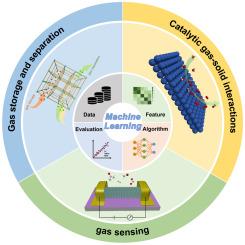当前位置:
X-MOL 学术
›
Coord. Chem. Rev.
›
论文详情
Our official English website, www.x-mol.net, welcomes your
feedback! (Note: you will need to create a separate account there.)
Machine learning for gas–solid interaction materials and devices
Coordination Chemistry Reviews ( IF 20.3 ) Pub Date : 2024-11-15 , DOI: 10.1016/j.ccr.2024.216329 Peiyuan Liu, Xiaoyang Zhu, Xu Ran, Hengchang Bi, Xiao Huang, Ning Gu
Coordination Chemistry Reviews ( IF 20.3 ) Pub Date : 2024-11-15 , DOI: 10.1016/j.ccr.2024.216329 Peiyuan Liu, Xiaoyang Zhu, Xu Ran, Hengchang Bi, Xiao Huang, Ning Gu

|
Gas–solid interactions that involve various chemical and physical processes are important in various research fields such as gas storage and separation, catalysis, and gas sensing. The design and study of gas–interfacing materials and processes require thorough considerations on the structural, chemical and electrical properties at the gas–solid interfaces. However, due to the large number of materials available, conventional trial-and-error attempts take long development cycles and high costs. The recent advancement of machine learning (ML) for gas–solid interactions adequately addresses this challenge and provides new insights into materials design and property prediction, thus deserving a critical review and in-depth discussion. In this contribution, we reviewed the application of various ML methods in the development of materials and devices involving gas–solid interactions, focusing on the elaboration of the structure–property relationship established by ML models. We also discussed the potential opportunities and challenges for the future development in this field.
中文翻译:

用于气固相互作用材料和器件的机器学习
涉及各种化学和物理过程的气固相互作用在气体储存和分离、催化和气体传感等各个研究领域都很重要。气体接口材料和工艺的设计和研究需要全面考虑气-固界面的结构、化学和电气特性。然而,由于可用的材料数量众多,传统的试错尝试需要较长的开发周期和高成本。用于气固相互作用的机器学习 (ML) 的最新进展充分解决了这一挑战,并为材料设计和性能预测提供了新的见解,因此值得批判性审查和深入讨论。在这篇文章中,我们回顾了各种 ML 方法在涉及气固相互作用的材料和设备开发中的应用,重点是详细阐述 ML 模型建立的结构-属性关系。我们还讨论了该领域未来发展的潜在机遇和挑战。
更新日期:2024-11-15
中文翻译:

用于气固相互作用材料和器件的机器学习
涉及各种化学和物理过程的气固相互作用在气体储存和分离、催化和气体传感等各个研究领域都很重要。气体接口材料和工艺的设计和研究需要全面考虑气-固界面的结构、化学和电气特性。然而,由于可用的材料数量众多,传统的试错尝试需要较长的开发周期和高成本。用于气固相互作用的机器学习 (ML) 的最新进展充分解决了这一挑战,并为材料设计和性能预测提供了新的见解,因此值得批判性审查和深入讨论。在这篇文章中,我们回顾了各种 ML 方法在涉及气固相互作用的材料和设备开发中的应用,重点是详细阐述 ML 模型建立的结构-属性关系。我们还讨论了该领域未来发展的潜在机遇和挑战。


















































 京公网安备 11010802027423号
京公网安备 11010802027423号